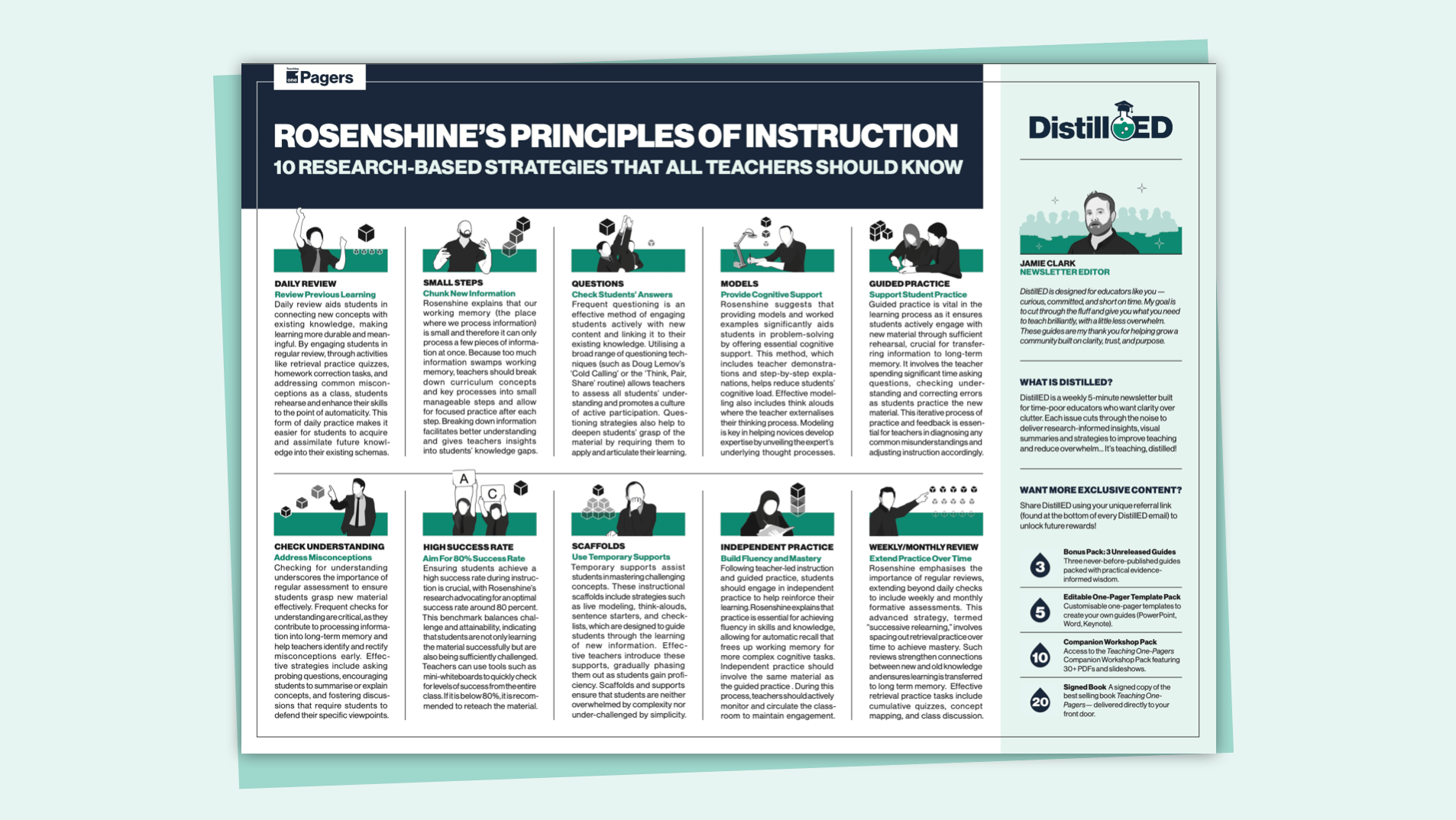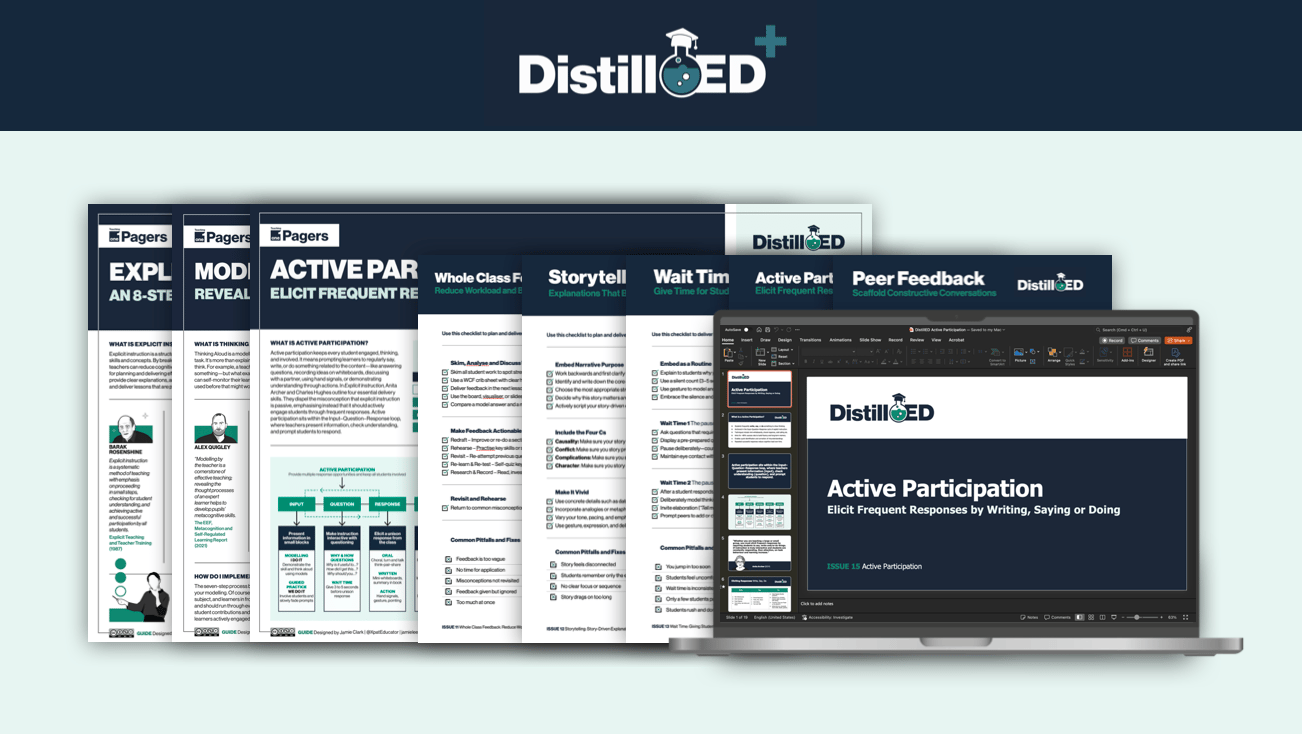👋 Hi {{first name | friend!}}
In this edition of ⚗️DistillED, we’re looking at one of Rosenshine’s most practical (and underrated) principles — Guided Practice. If Provide Models is about making expert thinking visible, Guided Practice is about giving students enough supported rehearsal so that the thinking sticks — and sticks correctly.

Barak Rosenshine’s Principles of Instruction
Barak Rosenshine (1930–2017) was an American educational psychologist whose research focused on effective teaching. Drawing on classroom observation, cognitive science, and teacher expertise, he developed the Principles of Instruction—ten practical guidelines that highlight what the most effective teachers do.

These principles emphasise reviewing prior knowledge, presenting material in small steps, checking for understanding, guiding practice, and ensuring all students are successful before moving to independence. They’ve since become a cornerstone of explicit teaching and evidence-informed practice worldwide.
What is Guided Practice?
Guided Practice is the “We Do” phase between teacher modelling and student independence. Instead of moving straight from demonstration to “off you go,” it’s about staying with the class, prompting, questioning, and correcting as students practise new material in small steps. As Rosenshine explains:
“Successful teachers spend more time guiding students’ practice of new material… It is not enough simply to present students with new material, because the material will be forgotten unless there is sufficient rehearsal.”
The goal is for every student to reach a point where they can apply the new learning correctly and fluently — before you release them to independent work. Think of this process as scaffolded rehearsal:
Co-Work First Steps: Working the first few problems together on the board.
Students Teach It Back: Asking students to explain each step back to you.
Coach on the Move: Circulating and coaching as they try it themselves.

So why is this so important? Let’s jump into some key research…
Why is Guided Practice Important?
Research in cognitive science shows that new learning is fragile, ephemeral and can easily be forgotten. Without enough rehearsal, students quickly forget or encode misconceptions. Rosenshine puts it plainly:
“When there has been sufficient rehearsal, the students are able to retrieve this material easily and thus are able to make use of this material to foster new learning and aid in problem solving. But when the rehearsal time is too short, students are less able to store, remember, or use the material.”
Guided Practice helps because:
Rehearsal strengthens memory: Students rephrase, elaborate, and summarise new material, embedding it in long-term memory.
Feedback prevents misconceptions: Immediate correction stops errors from becoming habits (practice can be a disaster if students are practising errors).
Prepares students for independence: Students who experience enough guided practice make fewer mistakes and feel more confident in seatwork and homework.
Studies of effective teachers show they spend significantly more time on guided practice than less effective teachers, combining short explanations with supervised student work until success rates hit ~80%.
The diagram below visualises how small steps and dedicated practice helps students process new information and rehearse it until it become fluent. This increases the likelihood that it will be encoded and connected to existing knowledge in long-term memory.

So, how do we make sure guided practice isn’t just a mechanical ‘we do’ phase, but a launchpad from modelling to confident, independent mastery?
Let’s find out.
DistillED+ PD Resources
Did you know, DistillED+ subscribers get instant access to exclusive PD resources such as new one-page guides, checklists and PowerPoint slides?

How do I Implement Guided Practice?
To make Guided Practice effective, it needs to be deliberate, active, and feedback-rich. Before adopting the 6-step routine below, keep these foundations in mind:
Keep It Targeted: Focus on just-taught content or a single step in a skill. Short bursts of rehearsal beat long, unfocused “work time.”
Mix the Format: Rotate between co-working examples, students teaching it back, quick drills, and error-spotting to keep guided practice fresh and engaging.
Guided Practice Formats
Guided Practice isn’t just “do a worksheet together.” Vary the rehearsal so it’s active, inclusive, and feedback-rich. Check out Tom Sherrington’s Rosenshine’s Masterclass video to find out more.
Here are some practical options when implementing guided practice:
Co-Work the First Steps: Solve the first few problems together on the board while narrating your thinking.
Teach It Back: Have students explain each step or answer aloud to you or a partner, checking their reasoning.
Coach on the Move: Circulate as students try it themselves; prompt, question, and correct in real time.
Worked Example → Problem Pair: Show a complete worked example, then set an almost-identical problem for students to solve.
Error Hunt: Present a partly wrong worked example and ask students to find and fix the mistakes.
Think-Pair-Practise: Students try a short task individually, discuss strategies with a partner, then try it again.
Whiteboard Drill: Use mini-whiteboards for rapid-fire practice with instant whole-class feedback.
Scaffold & Fade: Provide a checklist or prompt sheet for the first few attempts, then gradually remove supports as accuracy improves.
Here’s a simple six step approach for guided practice:
Step | Explanation | Example |
|---|---|---|
1. Frame the Practice
| Make clear that the goal is accuracy and confidence, not a test. Position guided practice as a warm-up to independence. | “Let’s try the first few questions together so we can all get the steps right before you go off on your own.” |
2. Model + Co-Work
| Work the first example(s) aloud, narrating your thinking. Then co-construct one with students, prompting them to supply steps. | “Watch how I set up the equation… Now let’s do the next one together: what’s our first step?” |
3. Prompt Student Explanation
| Ask students to explain or justify each step back to you or a partner. This surfaces misconceptions early. | “Turn to your neighbour and explain why we subtract here, not add.” |
4. All-in Practice
| Design a quick, visible way for everyone to rehearse (mini-whiteboards, paired explanation practice). | “Everyone solves question 2 on your boards… 3,2,1—show.” |
5. Give Immediate Feedback
| Circulate, listen, and correct in real time. Highlight common errors and reteach if needed. | “I’m seeing some slips with negative signs — pause, let’s fix that together.” |
6. Gradually Release
| As accuracy improves, fade prompts and increase the complexity or independence of the task. Prepare students for solo work. | “You’ve nailed the first three with support — try the next two on your own, but you can check in if stuck.” |
Those small, deliberate bursts of guided practice — modelling, co-working, prompting, and feedback — are the bridge from shaky first attempts to fluent, independent performance.
Until next time — keep engineering success for every student.
Jamie
Where can I find out more?
Guided Practice Lesson Planner Free Download
To support your use of Guided Practice, I’ve created a one-page Lesson Planner Template — an editable, printable sheet where you can map out each phase of guided practice: modelling, co-working, student explanation, whole-class rehearsal with feedback, and the transition to independent work. Perfect for making your guided practice deliberate, varied, and feedback-rich every time.

DistillED+ Checklist and Slideshow
This week’s ⚗️DistillED+ resources are a Guided Practice Checklist and a CPD Slideshow. Together, they walk through the WHAT, WHY, and HOW of using guided practice to scaffold new learning, strengthen accuracy through rehearsal, and build every student’s confidence before they go it alone.
If you’re a ⚗️DistillED+ member, scroll down to the bottom of this post to download the exclusive content.

Upgrade to DistillED+ to get this content!
Join DistillED+
Members gain access to expertly curated digital evidence-informed content
UPGRADEA ⚗️DistillED+ subscription gets you:
- Full access to new premium one-page guides
- Full access to evidence-informed strategy checklists
- Full access to slide templates (PowerPoint and Keynote)


